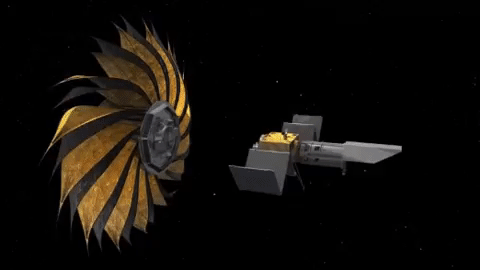Blog
Future’s So Bright,
I Gotta Wear Shades
25 September 2019
In the mid-2020s, NASA will launch the Wide Field Infrared Survey Telescope (WFIRST). One of its missions will be to study planets orbiting distant stars, including direct imaging of many of the larger planets.
But imaging exoplanets directly is a huge challenge. While a planet does emit infrared light, it is overwhelmed by the brilliant light of a star. It would be like trying to capture the light of a firefly fluttering near a large spotlight. To see the firefly, you somehow have to block the light of the spotlight.
 NASA/JPL/Caltech
NASA/JPL/CaltechOne of the more ambitious ways to do this would be to launch a telescope with a separate thin foil sheet. By placing the sheet some distance away from the telescope, the light of a star could be blocked while allowing the light from planets to be observed. This is the idea behind NASA’s Starshade project. But Starshade is still in the idea stage. The logistics of aligning the telescope and starshade in space, and keeping them aligned, is a huge technical challenge. Fortunately there is another way to block starlight, known as a coronagraph.
A coronagraph is similar to a starshade, except it is placed in the telescope itself. The starshade or “mask” is placed in the path of light passing through the telescope to block the light of the star. But because the mask is close, rather than far away, there’s a blurring effect due to the waves of light interfering with each other. This creates concentric circles of bright and dark lines in the telescope’s image. So you need another set of masks to minimize them. And you need computer software to enhance the images you get, and you need adaptive optics to account for random fluctuations in the starlight. It’s a complex system, but unlike the starshade idea we have built and used coronagraphs before. They are a well-established tool of ground-based astronomy. What we haven’t done is to use a coronagraph in space.
Over the past several years, NASA has been conducting a series of tests to ensure a space coronagraph would work. Recently NASA announced that the WFIRST coronagraph has passed its preliminary design review, meaning that construction of the coronagraph can begin. So when WFIRST launches, it will be equipped with a pair of “starglasses” capable of blocking out a billion photons from the star to capture a single photon from a planet.